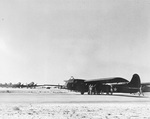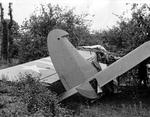CG-4A
| Country | United States |
| Manufacturer | Weaver Aircraft Company |
| Primary Role | Glider |
| Maiden Flight | 1 May 1942 |
Contributor: David Stubblebine
ww2dbaseThe WACO CG-4 was the most widely used United States troop/cargo military glider of World War II. It was designated the CG-4A by the United States Army Air Forces and called the Hadrian in British military service, but was universally known as the WACO, initials of the company that developed it: the Weaver Aircraft Company of Ohio.
ww2dbaseThe legendary actions of the 82nd and 101st Airborne Division paratroopers are fairly well known, but fewer people remember the other airborne unit type, the glider-borne infantry. The glider infantry was unique to WWII; it was developed in the early days of the war by the Germans and was disbanded in the years just after the war. Although the US Army also used limited numbers of the larger British Horsa Glider, the mainstay of US airborne operations was the Waco CG-4A. The CG-4A was constructed of tubular steel frame with a covering of cotton aircraft fabric, and plywood flooring and wings. It could carry a normal load of 7,500 lbs., but in emergencies could handle up to a maximum 9,000 lbs. The glider was designed for a maximum speed of 150 mph, with a normal glide (descent) speed of 72 mph. Landing speed was 60 mph, and its stall speed was 49 mph. Speed, obviously, was not one of the Waco's strong points.
ww2dbaseThe CG-4A found favor where its small size was a benefit. The larger British Airspeed Horsa could carry more troops and the British General Aircraft Hamilcar could carry a light tank; but the Horsa demanded a faster landing speed, which accounted for nearly all Horsa's receiving some degree of damage in combat landings and, therefore, injuries to the troops inside. The CG-4A could land in smaller spaces and by using a fairly simple net system, an in-flight C-47 equipped with a tail hook could "pick up" a CG-4A waiting on the ground.
ww2dbaseGlider troops who rode in the CG-4A were issued Mae West life jackets, but not parachutes. The gliders were towed behind C-47's then released from their tow line once over the "LZ" (landing zone). The highly trained and courageous glider pilots would then have a few scant minutes to pick out a likely landing spot, avoid all the other gliders also trying to make their landings, put the glider down on the ground without cracking it up in a ditch or slamming into trees or hedgerows, and accomplish all this while under withering fire from the enemy - and with only one chance to land safely; there were no "go-arounds" in a powerless aircraft! Further, unlike pilots of other aircraft types, glider pilots had to be double-trained as pilots and as combat soldiers of the glider-infantry. When the perilous landings were accomplished, the pilots had to be ready to become part of the fighting force.
ww2dbaseThe purpose of the glider-borne infantry was to put a fighting force on the ground, ready to move out and fight as a team. Quite often the paratroopers were scattered during their drop, and precious hours were lost while trying to regroup and get enough men together so that they could function as a capable fighting unit.
ww2dbaseBefore the invasion of Normandy, it was feared that the glider forces could face 50%-70% losses before even getting into combat, due to crash landings and the German defenses especially designed to stop the glider landings. It was felt by some that these men were simply being sacrificed for no gain. General Eisenhower insisted that the glider assault take place. The actual initial losses in crash landings and other causes were only 10-15%, and the glider forces proved crucial to the success of the Normandy invasion forces at Utah Beach.
ww2dbaseDevelopment and Operational History
ww2dbaseDesigned by Weaver Aircraft Company of Ohio (or WACO), CG-4 flight testing began in May 1942, and eventually more than 13,900 CG-4A's were delivered. At the height of production, sixteen companies were primary contractors for manufacturing Waco's, including the Ford Motor Company. There were also hundreds of sub-contractors.
ww2dbaseWhiteman Air Force Base was originally activated on 6 August 1942, as Sedalia Glider Base. In November 1942, the installation became Sedalia Army Air Field and was assigned to the 12th Troop Carrier Command of the United States Army Air Forces. The field served as a training site for glider pilots and paratroopers. Assigned aircraft included the CG-4A glider, and the Curtiss C-46 and Douglas C-47. However, the C-46 saw limited use as a glider tug in combat.
ww2dbaseWaco's went into operation in July 1943 during the Allied invasion of Sicily. They participated in the American airborne landings in Normandy on 6 June 1944, and in other important airborne operations in Europe and in the China-Burma-India Theater. Although not the intention of the AAF, gliders were generally considered expendable by high ranking European theater officers and combat personnel and were abandoned or destroyed after landing. While equipment and methods for extracting flyable gliders was developed and was delivered to Europe, half of that equipment was rendered unavailable by certain higher ranked officers. Despite this lack of support for the recovery system several gliders were recovered from Normandy and even more from Holland and Wesel. The CG-4A was also used to send supplies to partisans in Yugoslavia.
ww2dbaseSources: 325th Glider Infantry Association, Charles L. Day, Wikipedia, WWII Glider Pilots Association.
Last Major Revision: Dec 2008
SPECIFICATIONS
CG-4A
| Armament | Can carry 13 glider troops, or 1x37mm AT gun, or 1x75mm pack howitzer, or 1 Jeep vehicle |
| Crew | 2 |
| Span | 25.50 m |
| Length | 14.80 m |
| Height | 4.70 m |
| Wing Area | 83.60 m² |
| Weight, Empty | 1,719 kg |
| Weight, Loaded | 3,400 kg |
| Weight, Maximum | 4,091 kg |
| Speed, Maximum | 240 km/h |
| Speed, Cruising | 117 km/h |
Photographs
 |  |  |  |
Did you enjoy this article or find this article helpful? If so, please consider supporting us on Patreon. Even $1 per month will go a long way! Thank you. Share this article with your friends: Stay updated with WW2DB: |
Visitor Submitted Comments
7 Jul 2012 11:05:10 AM
yes they were.i remember there being three of them in the fields near bethlehem,pa.they were bought for the crates it came in.i heard it came in three crates.there was enough lumber in the crates to build a house.as a kid we played in the gliders.they had all the instruments anmd the tires.my family has always been in construction.my cousin who is older than me told me his father bought three of them.my cousin drove to tobyhanna with a flat bed truck to get them.i don't know how many trips it took.but they built houses with the lumber from the crates.i remember seeing the gliders in the fields around town.rural of course.
19 May 2015 11:24:04 PM
The first general officer on either side to be killed on D-Day was Brigadier-General Don F. Pratt, the assistant divisional commander of the 101st Airborne Division who was crushed to death when the Waco glider in which he was travelling crashed into a hedgerow whilst landing in France. He was also the highest ranking Allied officer to be killed on 6 June 1944.
3 Aug 2015 07:04:06 AM
FIVE shipping crates per glider not three.
BGen Pratt was not crushed, his neck was broken-whiplash.
13 Jan 2016 07:55:20 PM
My Father was Lt. Cletus V Schultetus , 29 Squadron 313 Troop Carrier Division. His Glider Pilots License was #413 Entered serice December 8th 1941. Training at 29 Palms California, Service North Africa, Sicily, Italy, France, Holland, Rhine Drop Germany, Left Service in 1946. Arlington National Cemetary,
3 Jan 2018 07:16:19 PM
Hi Layne,
My dad was Lt. William E. Schumacher, a colleague and
friend of your father's. Served
as a glider pilot in the 29th, N.Africa, Sicily, France, Holland and Germany. Did you get a copy of "We Are The 29Th?" It has your dad's name and anecdotes.
18 Jan 2018 11:40:11 AM
Hi Layne and Jim, I am researching WWII gliders and pilots, and collecting as much as I can, and would appreciate both of you contacting me.
Thank you
scott1ramsey@gmail.com
19 Sep 2018 07:55:59 AM
My father worked on these aircraft at Laister-Kauffmann who was one of the glider assembly companies during the war.
23 Jan 2021 10:12:30 AM
Layne and Jim, my father Piero (Pete) Squillo served in the 29th as well. He came in Dec. 44 and flew the CG-13A as well as the CG-4A. I'm trying to find names for faces in some of the candids and group photos he had in his collection. It's been 2 years since your post, so I'm hoping you get this. Let me know what you may have that could help.
17 Apr 2021 11:05:08 AM
Can anyone familiar with the subject of graduation wings issued to Glider pilots tell me if the position "Senior Glider Pilot" ever existed and if Glider Pilot wings with a star affixed ever existed? Many thanks?
All visitor submitted comments are opinions of those making the submissions and do not reflect views of WW2DB.
- » Wreck of USS Edsall Found (14 Nov 2024)
- » Autumn 2024 Fundraiser (7 Nov 2024)
- » Nobel Peace Prize for the Atomic Bomb Survivors Organization (11 Oct 2024)
- » Wreck of USS Stewart/DD-224 Found (2 Oct 2024)
- » See all news
- » 1,150 biographies
- » 337 events
- » 43,917 timeline entries
- » 1,241 ships
- » 350 aircraft models
- » 207 vehicle models
- » 374 weapon models
- » 123 historical documents
- » 260 facilities
- » 470 book reviews
- » 28,543 photos
- » 432 maps
Joachim von Ribbentrop, German Foreign Minister, Aug 1939
Please consider supporting us on Patreon. Even $1 a month will go a long way. Thank you!
Or, please support us by purchasing some WW2DB merchandise at TeeSpring, Thank you!
4 Sep 2010 03:47:47 PM
Were any of these gliders ever sold to the public after the war? Don